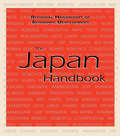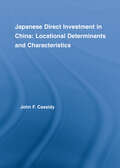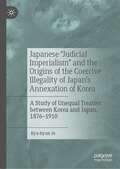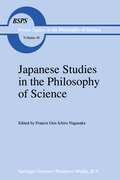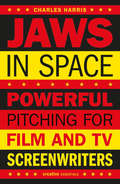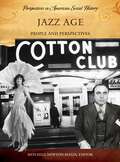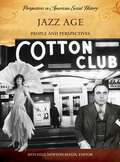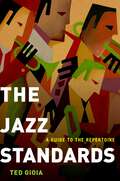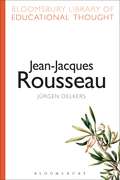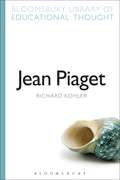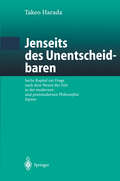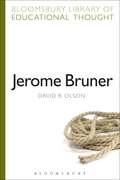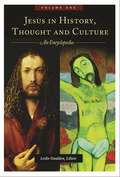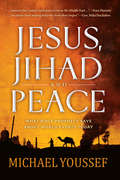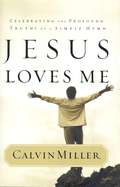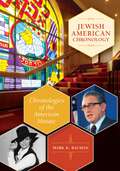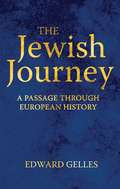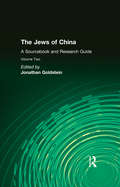- Table View
- List View
The Japan Handbook (Regional Handbooks of Economic Development #Vol. 3)
by Patrick HeenanFirst Published in 1999. Routledge is an imprint of Taylor & Francis, an informa company.
Japanese Direct Investment in China: Locational Determinants and Characteristics
by John F. CassidyChina, with the world's largest population, is set to become the second largest market in the world by 2010. The importance of understanding the environment for foreign direct investment (FDI) in China has never been more apparent. With this as a context, this book examines FDI in China with the emphasis on the 'where to locate' question. Japanese direct investment is used as a case study elucidating the key locational determinants and characteristics thereof. This is the first book focusing on the 'where to locate' question with respect to the China market. All companies with a China strategy and all university business departments will find this book of vital importance.
Japanese Direct Investment in China: Locational Determinants and Characteristics
by John F. CassidyChina, with the world's largest population, is set to become the second largest market in the world by 2010. The importance of understanding the environment for foreign direct investment (FDI) in China has never been more apparent. With this as a context, this book examines FDI in China with the emphasis on the 'where to locate' question. Japanese direct investment is used as a case study elucidating the key locational determinants and characteristics thereof. This is the first book focusing on the 'where to locate' question with respect to the China market. All companies with a China strategy and all university business departments will find this book of vital importance.
Japanese Drama and Culture in the 1960s: The Return of the Gods (Routledge Revivals)
by D.G. GoodmanThis title was first published in 1988: In this book the author has translated five postwar experimental Japanese plays and recreated the artistic, social and spiritual milieu in which they were created. He describes the turning point in Japanese thinking about the nature and limitations of a Western-oriented modern culture, and the creation of "underground" theatres which in which evolved a new mythology of history. Professor Goodman sees these developments as an interplay between personal and political (ie revolutionary) salvation.
Japanese Drama and Culture in the 1960s: The Return of the Gods (Routledge Revivals)
by D.G. GoodmanThis title was first published in 1988: In this book the author has translated five postwar experimental Japanese plays and recreated the artistic, social and spiritual milieu in which they were created. He describes the turning point in Japanese thinking about the nature and limitations of a Western-oriented modern culture, and the creation of "underground" theatres which in which evolved a new mythology of history. Professor Goodman sees these developments as an interplay between personal and political (ie revolutionary) salvation.
Japanese "Judicial Imperialism" and the Origins of the Coercive Illegality of Japan's Annexation of Korea: A Study of Unequal Treaties between Korea and Japan, 1876–1910
by Kyu-hyun JoThis book explores the legacy of the Japanese empire in Korea, asking how colonialism arose as a legal idea. What was the legal process behind the establishment of colonialism as Japan's prime strategy towards Korea since the late 19th century? By addressing such questions, it is not only possible to address how Japanese colonialism in Korea was born, but also address how the process behind the making of colonialism as a judicial and legal project was illegal from its origination. As East Asia grapples with a new generation of power politics, these sober reflects lend an important historical context to the struggles of the present.
Japanese Studies in the Philosophy of Science (Boston Studies in the Philosophy and History of Science #45)
by Robert S. CohenThe splendid achievements of Japanese mathematics and natural sciences during the second half of our 20th century have been a revival, a Renaissance, of the practical sciences developed along with the turn toward Western thinking in the late 19th century. The equally admirable results of Japanese philosophers (and historians) of science in our time followed upon a period less congenial to Western interests in the philosophical questions linked to modern science; and this reluctance to confront the epistemology, not even the humane significance, of the sciences went along with devotion to other Western trends. Thus, with the 'new' Japan of the Meiji restoration of 1868, and the early introduction of Western philosophy in the subsequent decade by Nishi Amane, a period of intellectual attraction to utilitarian, positivist, evolutionary, even materialist outlooks was soon replaced by devotion to scholarly work on Kant and Hegel, on ethical and general philosophical idealism. These studies often could emulate the critical spirit (the philosopher Onishe Hajime, praised for his own critical independence, was known as the Japanese Kant) but the neo Kantian and neo-Hegelian developments were not much affected by either empirical sciences or theoretical speculations about Nature. The pre-eminent philosopher of Japan ofthe first half of our century was Nishida Kitaro, with a pioneering treatise A Study of the Good, who, with his leading student Tanabe Hajime, formed the 'Kyoto School' of pre-war philosophy.
Jatin Shah's Head and Neck Surgery and Oncology E-Book: Expert Consult: Online and Print
by Jatin P. Shah Snehal G. Patel Bhuvanesh SinghHead and Neck Surgery and Oncology, by Drs. Jatin P. Shah Snehal G. Patel, and Bhuvanesh Singh, offers you authoritative, multidisciplinary guidance on the latest diagnostic and multidisciplinary therapeutic approaches for head and neck cancer. With this medical reference book, you’ll have all the help you need to offer your patients the best possible prognoses and to optimally preserve and restore form and function. Overcome any challenge in head and neck surgery with comprehensive coverage of the scalp, skull base, paranasal sinuses, oral cavity, pharynx, larynx, cervical lymph nodes, thyroid, salivary glands, and soft tissue and bone tumors - from incidence, diagnosis, and work up through treatment planning, operative techniques, rehabilitation, and outcomes. Increase your understanding of head and neck oncology with this completely reorganized edition, presenting a uniform flow of topics, which includes the latest information on Diagnostic approaches, staging, algorithms for selection of therapy, and outcomes of treatment for head and neck tumors. Offer today’s best treatment options with outcomes of therapy data from the NCDB, institutional data from MSKCC, and evidence-based information Diagnose patients using the latest advances in radiographic imaging, diagnostic pathology and molecular biology. Take fullest advantage of every multidisciplinary management approach available including radiation oncology, medical oncology (including targeted therapies), maxillofacial prosthodontics and dental oncology, surgical procedures for salvage of recurrences after chemoradiation therapy, and rehabilitation measures to improve functional outcomes (speech, swallowing, etc.). Understand the nuances of day-to-day practical care of patients with basic operating room techniques and technology, intraoperative decisions, and post operative care for patients undergoing head and neck surgery. Know what to look for and how to proceed with sequential operative photographs of each surgical procedure and full-color artwork to demonstrate anatomical relationships. Particular emphasis is placed on surgical management of patients after chemo-radiotherapy, reflecting the changing paradigms in head and neck oncology and the special challenges that confront modern day head and neck surgeons.
Jaws In Space: Powerful Pitching for Film and TV Screenwriters
by Charles HarrisTwo screenwriters once walked into a Hollywood producer's office and said three words 'Jaws in space.' Those three words won them the contract for the blockbuster movie Alien.The ability to pitch well is essential for all writers, directors and producers in cinema and TV, drama, documentary and series. Strong pitching skills will accelerate your career - not only helping you sell your projects, but also developing them in the first place, focusing on what makes a story work, clarifying character and plot, and working more successfully with industry collaborators.This book takes you from the essentials of what makes a good pitch to advanced skills that will help you in all kinds of pitching situations. Charles Harris gives a clear-sighted view of how pitching works in the industry and a series of very practical techniques for developing a gripping and convincing pitch. Drawing on his experience, he examines the problems that can arise with both mainstream and unconventional projects - from a range of different cultures - and explains how to solve them. He also analyses the process of taking a pitch meeting and shows you how to ensure you perform at your best.'Everything you need to know about pitching and a whole lot more' - Nicola Quilter'Charles Harris has created the perfect handbook for anyone who is a bit uncertain or scared about pitching their work' - writesofluid.com'Charles makes the whole process of pitching seem so enjoyable' - Lock and Load, Brides of Christ
Jazz Age: People and Perspectives (Perspectives in American Social History)
by Mitchell Newton-Matza & Peter C. Mancall,A collection of essays encompassing a wide variety of topics, people, and events that embodied the Jazz Age, both familiar and obscure.This volume in ABC-CLIO's social history series, People and Perspectives, looks at one of the most vibrant eras in U.S. history, a decade when American life was utterly transformed, often veering from freewheeling to fearful, from liberated to repressed.What did it mean to live through the Jazz Age? To answer this and other important questions, the volume broadens the spotlight from famous figures to cover everyday citizens whose lives were impacted by the times, including women and children, African Americans, rural Americans, immigrants, artists, and more. Chapters explore a wide range of topics beyond the music that came to symbolize the era, such as marriage, religion, consumerism, art and literature, fashion, the workplace, and more—the full cultural landscape of an extraordinary, if short-lived, moment in the life of a nation.
Jazz Age: People and Perspectives (Perspectives in American Social History)
by Mitchell Newton-MatzaA collection of essays encompassing a wide variety of topics, people, and events that embodied the Jazz Age, both familiar and obscure.This volume in ABC-CLIO's social history series, People and Perspectives, looks at one of the most vibrant eras in U.S. history, a decade when American life was utterly transformed, often veering from freewheeling to fearful, from liberated to repressed.What did it mean to live through the Jazz Age? To answer this and other important questions, the volume broadens the spotlight from famous figures to cover everyday citizens whose lives were impacted by the times, including women and children, African Americans, rural Americans, immigrants, artists, and more. Chapters explore a wide range of topics beyond the music that came to symbolize the era, such as marriage, religion, consumerism, art and literature, fashion, the workplace, and more—the full cultural landscape of an extraordinary, if short-lived, moment in the life of a nation.
The Jazz Standards: A Guide to the Repertoire
by Ted GioiaThe Jazz Standards, a comprehensive guide to the most important jazz compositions, is a unique resource, a browser's companion, and an invaluable introduction to the art form. This essential book for music lovers tells the story of more than 250 key jazz songs, and includes a listening guide to more than 2,000 recordings. Many books recommend jazz CDs or discuss musicians and styles, but this is the first to tell the story of the songs themselves. The fan who wants to know more about a jazz song heard at the club or on the radio will find this book indispensable. Musicians who play these songs night after night now have a handy guide, outlining their history and significance and telling how they have been performed by different generations of jazz artists. Students learning about jazz standards now have a complete reference work for all of these cornerstones of the repertoire. Author Ted Gioia, whose body of work includes the award-winning The History of Jazz and Delta Blues, is the perfect guide to lead readers through the classics of the genre. As a jazz pianist and recording artist, he has performed these songs for decades. As a music historian and critic, he has gained a reputation as a leading expert on jazz. Here he draws on his deep experience with this music in creating the ultimate work on the subject. An introduction for new fans, a useful handbook for jazz enthusiasts and performers, and an important reference for students and educators, The Jazz Standards belongs on the shelf of every serious jazz lover or musician.
Jean-Jacques Rousseau (Bloomsbury Library of Educational Thought)
by Jurgen OelkersJean-Jacques Rousseau, enlightenment philosopher and founder of 'natural education', is one of the most influential philosophers of education in the western world. In order to fully understand Rousseau's impact as a true educational thinker, Jurgen Oelkers argues that we must take into account his paradoxical style, unique intellectual biography and his turbulent and unconventional way of life. Combining historical analysis and contemporary ethical theory, this text serves as both an introduction to Rousseau's theories of education and a critique of his views, and shows how Rousseau was a pioneer in exploring educational issues within the context of his own philosophical problems in order to present innovative solutions.
Jean-Jacques Rousseau (Continuum Library of Educational Thought)
by Jurgen Oelkers Richard BaileyJean-Jacques Rousseau, enlightenment philosopher and founder of 'natural education', is one of the most influential philosophers of education in the western world. In order to fully understand Rousseau's impact as a true educational thinker, Jurgen Oelkers argues that we must take into account his paradoxical style, unique intellectual biography and his turbulent and unconventional way of life. Combining historical analysis and contemporary ethical theory, this text serves as both an introduction to Rousseau's theories of education and a critique of his views, and shows how Rousseau was a pioneer in exploring educational issues within the context of his own philosophical problems in order to present innovative solutions.
Jean Piaget (Bloomsbury Library of Educational Thought)
by Richard KohlerJean Piaget was one of the great thinkers of the twentieth century. His influence on developmental psychology, education and epistemology has been enormous. This text undertakes a reconstruction of the contexts and intellectual development of Piaget's numerous texts in the wide-ranging fields of biology, philosophy, psychoanalysis, child psychology, social psychology, theology, logic, epistemology and education.Richard Kohler reconstructs the often overlooked theological basis of Piaget's theories and analyses the influence this had upon the various areas of his research and reflections, particularly in relation to education.
Jean Piaget (Continuum Library of Educational Thought)
by Richard Kohler Richard BaileyJean Piaget was one of the great thinkers of the twentieth century. His influence on developmental psychology, education and epistemology has been enormous. This text undertakes a reconstruction of the contexts and intellectual development of Piaget's numerous texts in the wide-ranging fields of biology, philosophy, psychoanalysis, child psychology, social psychology, theology, logic, epistemology and education.Richard Kohler reconstructs the often overlooked theological basis of Piaget's theories and analyses the influence this had upon the various areas of his research and reflections, particularly in relation to education.
Jenseits des Unentscheidbaren: Sechs Kapitel zur Frage nach dem Wesen der Zeit in der modernen und postmodernen Philosophie Japans
by Takeo HaradaDie Abhandlung beleuchtet das für Europäer immer noch exotische Zeitverständnis der Japaner. Zur Vermittlung der geschichtlichen und soziologischen Voraussetzungen stellt der Autor die Werke der führenden japanischen Philosophen sowie Rechtswissenschaftler vor. Die Analyse führt zu dem Ergebnis, dass der Zeitbegriff im Bewußtsein der Japaner seit Beginn der landesweiten Modernisierung janusköpfig gestaltet ist: Einerseits wurde versucht, die Zukunftsorientiertheit der Japaner durch den totalen Bruch mit ihrer Vergangenheit herbeizuführen. Andererseits wurde jedoch zugleich ihre Sehnsucht nach dem Japanisch-Kaiserlichen als Symbol ihrer gemeinsamen Vergangenheit gestärkt. Diese Zwiespältigkeit trat nach Ansicht des Autors immer dann offen zutage, wenn die Beschleunigung der gesellschaftlichen Integration in Japan dringend geboten war.
Jerome Bruner: The Cognitive Revolution In Educational Theory (Bloomsbury Library of Educational Thought)
by David R. OlsonJerome Bruner is the vanguard of “the cognitive revolution” in psychology and the predominant spokesman for the role of culture and education in the making of the modern mind. In this text Olson encourages the reader to think about children as Bruner did, not as bundles of traits and dispositions to be diagnosed and remediated, but as thoughtful, keenly interested, agentive persons who are willing and indeed able to play an important role in their own learning and development.Through the unique approach of combining commentary and conversation with Bruner, the author provides an insight into what it is like to engage with one of the intellectual masters of our time and highlights the relevance and importance of his contribution to educational thinking today.
Jerome Bruner: The Cognitive Revolution In Educational Theory (Bloomsbury Library of Educational Thought)
by David R. Olson Richard BaileyJerome Bruner is the vanguard of "the cognitive revolution†? in psychology and the predominant spokesman for the role of culture and education in the making of the modern mind. In this text Olson encourages the reader to think about children as Bruner did, not as bundles of traits and dispositions to be diagnosed and remediated, but as thoughtful, keenly interested, agentive persons who are willing and indeed able to play an important role in their own learning and development.Through the unique approach of combining commentary and conversation with Bruner, the author provides an insight into what it is like to engage with one of the intellectual masters of our time and highlights the relevance and importance of his contribution to educational thinking today.
Jesus in History, Thought, and Culture [2 volumes]: An Encyclopedia [2 volumes]
by J. L. HouldenThis unique multidisciplinary study views Jesus as one of the most central figures in history with a wide-ranging impact on society, literature, art, and philosophy.Jesus in History, Thought, and Culture distills 2,000 years of thinking about Jesus into two intriguing volumes. In more than 200 A–Z entries, internationally recognized scholars summarize views of Jesus from the Gospel writers to contemporary theologians. Not only does the book explore Christian liturgy and worship—including the long-lasting 4th- and 5th-century schisms over whether Jesus is human or divine—but it examines the position of Jesus in the traditions of other world religions, such as Judaism, Islam, and Hinduism.Even outside religion, little has been untouched by Jesus's influence. Jesus affected social and political theory in his time and continues to do so today. The encyclopedia also explores his changing image in art, sculpture, music, and literature, pulling disparate fields of study into one powerful resource. Scholars, students of theology and world religions, and other interested readers will all welcome this unique resource.
Jesus, Jihad and Peace: What Bible Prophecy Says About World Events Today
by Michael YoussefJudaism, Christianity, and Islam all feature parallel accounts of the "end times," and all three accounts feature a messianic Savior, an apocalyptic final war between good and evil, and a central role for the city of Jerusalem. Do these three "end times" scenarios intersect in some way? In a world that cries out for peace, which will prevail -- Jesus or jihad?
Jesus Loves Me: Celebrating the Profound Truths of a Simple Hymn
by Calvin MillerThere are few songs more recognizable to the Christian believer than Anna B. Warner's beloved hymn, "Jesus Loves Me." The simple yet eloquent lyric states the basic elements of faith both plainly and succinctly; within the three title words are found the tenets of Christianity. Now, by examining this beloved hymn verse by verse, including the little known second and third stanzas, Calvin Miller seeks to remind believers of the clear and abiding truths found within this child's rhyme. In doing so, he establishes the song as a creed by which busy Christian adults can live and grow.
Jewish American Chronology: Chronologies of the American Mosaic
by Mark K. BaumanThis comprehensive and analytical history of American Jews and Judaism from the Colonial Era to the present explores the impact of America on Jews and of Jews on America.Covering more than four centuries from the Colonial Era forward, Jewish American Chronology offers an introduction to the history of American Jews and Judaism, using individual examples, personality profiles, and illustrations to bring fundamental patterns and major themes to life. Arranged chronologically, the entries illustrate how a variety of different Jewish groups and individuals have adapted to America, both changing in accordance with time and place and retaining tradition and culture, even as they became thoroughly American.Readers will learn how Jews have created community and institutions, confronted anti-Semitism, and interacted among themselves and with other groups. They will read about immigration, migration, and socioeconomic mobility. And they will discover how Jews have filled critical economic niches, contributed disproportionately in a variety of endeavors, and changed over time and in reaction to circumstances. In this wide-ranging work, Jewish Americans are depicted in a balanced and accurate manner, describing Nobel Prize winners and standout economic success stories as well as those who achieved fame and notoriety in other ways.
The Jewish Journey: A Passage through European History
by Edward GellesThe history of European Jewry is a vast and complex subject. In this book, Edward Gelles traces Jewish history in Europe and the Near East including population movement, settlement, integration, advancement in aspects of European culture and learning, relations with European states and dynasties, Christians and Ottomans, persecution, the world wars, anti-Semitism, indeed the story of European Jewry from early times to the present. Edward Gelles and his family, both immediate and in their wider circle have huge and distinguished family connections that provide historical context. In combining biography, traditional genealogy and a contribution from the rapidly developing field of genetic genealogy this book weaves emerging patterns into the grand tapestry of European history.
The Jews of China: v. 2: A Sourcebook and Research Guide
by Jonathan GoldsteinAn impressive interdisciplinary effort by Chinese, Japanese, Middle Eastern, and Western Sinologists and Judaic Studies specialists, these books scrutinize patterns of migration, acculturation, assimilation, and economic activity of successive waves of Jewish arrivals in China from approximately A.D.1100 to 1949.
